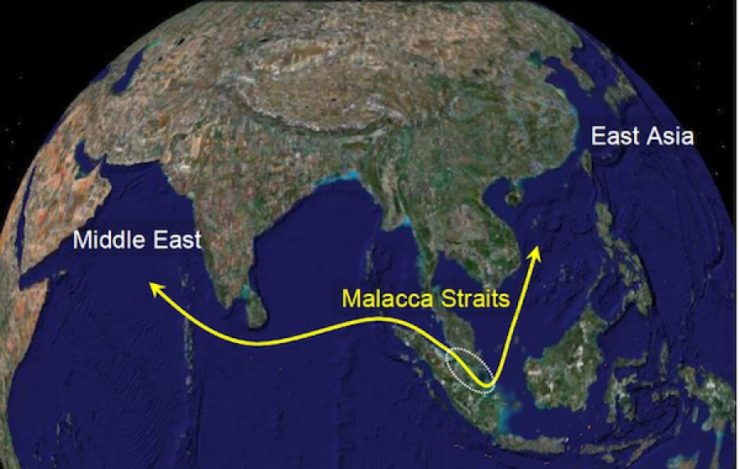
The term “Malacca Dilemma” was first coined by former Chinese President Ho Jintao in 2003. The term refers to potential menacing factors that could hamper Chinese economic growth and threaten its military might by choking its oil imports from the East Asian and Middle Eastern region through the Malacca Strait. The strait stretches to 1100 km in length and 2.8 km wide at its narrowest point, which makes the strait a great source of vulnerability for China. China is the top oil importer in the world. Almost 80 percent of energy imports pass through the Malacca Strait. The strait is a transit point for 16 million barrels per day. Moreover, crude imports by China reached 10 million barrels per day and are estimated to surge by 80 percent by 2030. Such a magnificent quantity of energy transported from the strait demonstrates its significance. President Hu Jintao held, in 2003, while referring to the Malacca Dilemma, that “certain powers have all along encroached on and tried to control navigation through the (Malacca) Strait.” By “certain powers”, the President obviously pointed to the United States.
China’s rise as the new global power is considered the most significant threat to the US hegemony in the world. Countries around the world see the conflict between the two powers as the most dangerous conflict in the world. Any direct confrontation between the two countries could lead to a nuclear war and take the whole world into its folds. The Malacca Strait is surrounded by the Malay Peninsula, Sumatra Island, and Singapore. This narrow strait could easily be choked by the rival nations of China. The United States sagaciously controls the Malacca Strait and the Indo-Pacific Ocean, as many regional countries are under the US influence.
Singapore is one of the key allies of the United States and India in the region – two archenemies of China. Although China is in direct competition with the United States, India also wants to replace China at the regional and global levels. Singapore can be influenced by these two countries, which could prove detrimental for China. This would decelerate China’s industrial and economic growth. The United States is rapidly increasing its presence in the Indo-Pacific region to counter the swift rise of China as the new superpower. Japan, India, the Philippines, Australia, and many other regional countries have cordial ties with the United States.
The significance of the region and the United States’ concern for the region could be gauged by former US President Obama’s “Pivot to Asia” policy. Former US Secretary of State, Hillary Clinton, declared the 21st Century as the Asian century. Furthermore, she said, “It is becoming increasingly clear that, in the 21st century, the world’s strategic and economic center of gravity will be the Asia-Pacific.” This demonstrates the magnitude of significance that the United States attributes to this region. The country is increasingly and rapidly militarizing the region. The United States has also commenced militarization of the QUAD nations. Moreover, the AUKUS pact is also one of the examples of militarization of the Indo-Pacific region. The United States and the UK have provided nuclear-powered submarines to Australia. Analysts around the world considered this act as a move to counter Chinese influence in the region.
Considering all these perils, China is taking measures to decrease its dependence on the Malacca Strait. China seeks to secure its military and economic trade from East Asia and the Middle East. China is building alternate trade routes to secure its trade from different regions. China’s Belt and Road Initiative (BRI) is intended to connect the country with different countries through the land route. Moreover, it is following the “Sting of Pearls” strategy, which refers to establishing naval bases and maritime infrastructure across the Indian Ocean to secure its sea trade. The China-Pakistan Economic Corridor (CPEC) is one of the flagship projects of the BRI. This project connects China with Gwadar Port, one of the most significant points in the String of Pearls strategy.
China has also established cordial relations with Bangladesh, Sri Lanka, Iran, and other regional countries in order to pursue its policy of decreasing dependence on the Malacca Strait. Furthermore, China’s Gwadar and Chabahar projects will secure Chinese trade from the Indian threat. China is also encircling India through this policy. However, the CPEC and Chabahar projects are facing many difficulties and are slow-paced due to the instability of the host countries. Political instability and surging terrorism in Pakistan have also hampered any significant progress on the CPEC project. Iran is also facing threats from the United States and Israel. Moreover, Chabahar Port needs stability in Afghanistan, which is considered a safe haven for terrorist organizations and a key reason for regional instability. Consequently, China is deemed to have struggled with its Malacca Dilemma for quite a long time because of these factors.
Abbas Hashemite – is a political observer and research analyst for regional and global geopolitical issues. He is currently working as an independent researcher and journalist, exclusively for “New Eastern Outlook”.
